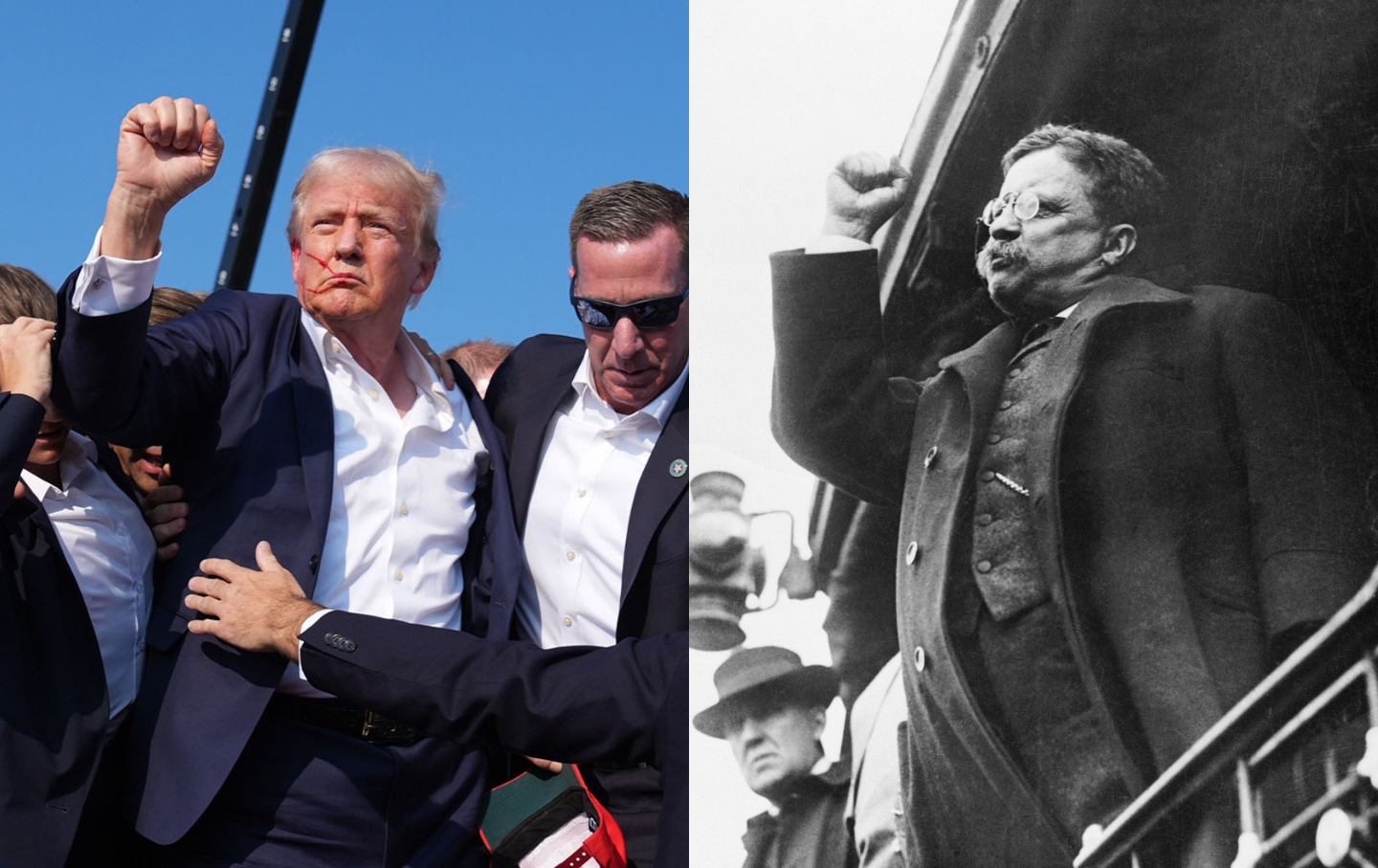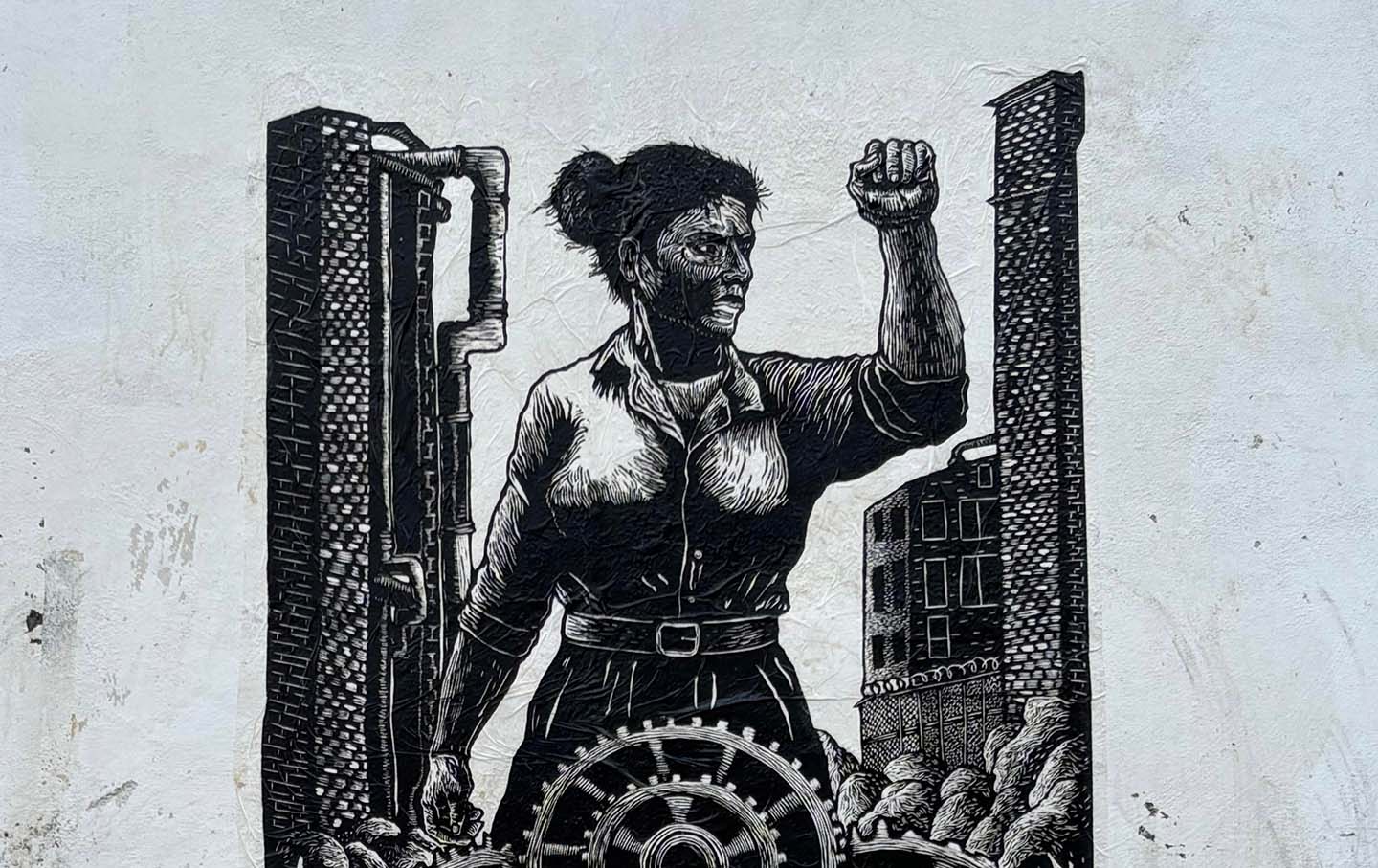Americans Know Political Violence All Too Well
The attempted assassination of Donald Trump recalls the shooting of Theodore Roosevelt in Milwaukee.

Donald Trump, 2024 / Theodore Roosevelt, 1912.
(Jabin Botsford / The Washington Post via Getty Images; Bettmann via Getty Images)Milwaukee—In the lobby of the Hyatt Regency Milwaukee, a hotel in the heart of the downtown district where delegates to this week’s Republican National Convention will nominate Donald Trump for a second term as president of the United States, there is a plaque that announces, “On this spot October 14, 1912, an attempt was made upon the life of Theodore Roosevelt.”
It is a measure of the all-too-common nature of political violence in America that Trump is not the first former president who, while making a comeback bid, survived an assassination attempt.
More than a century before Saturday afternoon’s horrific shooting incident at a Republican rally in Butler, Pennsylvania—where a rally attendee and the shooter died, and where Trump, as he said in a social media post, “was shot with a bullet that pierced the upper part of my right ear”—Roosevelt was targeted in a campaign-season assassination attempt. The shooting of Roosevelt sent shock waves through the 1912 election season, although the former president ultimately lost his reelection bid.
After Saturday’s shooting in Pennsylvania, media headlines fretted about the arrival of “A Terrible New Era of Political Violence in America.”
President Biden announced, “There is no place in America for this kind of violence.”
Biden was surely right when he decried the shooting as “sick” and said, “Everybody, everybody must condemn it.” Unfortunately, the historical record does not support the president’s assertion that “the idea that there’s political violence, or violence in America like this, is just unheard of.”
The reality is that political violence has been a feature of the American experiment for much of its 248 years. Four presidents have been shot and killed while in office—Abraham Lincoln, James Garfield, William McKinley, and John F. Kennedy. Another president, Ronald Reagan, was nearly killed by an assassin in 1981. President Gerald Ford was the target of two assassination attempts in September of 1975. Former US attorney general and New York Senator Robert F. Kennedy was murdered after winning California’s 1968 Democratic presidential primary. Four years later, Alabama Governor George Wallace was shot—by a 21-year-old Milwaukeean—and left paralyzed, as he campaigned in Maryland for the 1972 Democratic presidential nomination.
But despite all the bloody history, assassination attempts still come as a shock to Americans. We do not want to believe that this level of violence is an aspect of our politics. Even in periods when there have been multiple assassinations of prominent political figures—as happened in the spring of 1968, when both the Rev. Martin Luther King Jr. and RFK were murdered over the course of two awful months—no one is prepared for the moment when the shots ring out.
The attempt on Trump’s life left him injured but resilient. He raised a clenched fist as he was being led from the rally stage, in what will surely become one of the iconic images of the 2024 campaign. He will undoubtedly be welcomed as a wounded warrior by the delegates who will nominate him in Milwaukee, where already intense security was immediately ramped up after Saturday’s assassination attempt. (Tensions were already high in the city, after the June 30 use-of-force death of 43-year-old D’Vontaye Mitchell near the Hyatt Regency stirred a national outcry.)
Yet a joint statement from the Trump campaign and the Republican National Committee announced Saturday night that the 45th president “looks forward to joining you all in Milwaukee as we proceed with our convention to nominate him to serve as the 47th President of the United States.”
If Trump wins in November, he would be only the second former president to have mounted a successful bid for a new term—after Grover Cleveland, a Democrat who served as the 22nd and 24th commander in chief. But another former president attempted a comeback. That was Roosevelt, who had become president after the assassination of President McKinley in 1901 and who left office in 1909.
Roosevelt had served for almost eight years as a progressive Republican. When he ran again in 1912, however, he was rejected by that year’s Republican National Convention, in favor of the more conservative incumbent, President William Howard Taft. Roosevelt then mounted a bid as the candidate of the newly created Progressive Party, which was nicknamed the “Bull Moose” Party.
Roosevelt positioned himself to the left of the Republicans and Democrats, proposing a “New Nationalism” that sought “to dissolve the unholy alliance between corrupt business and corrupt politics.” His was a progressive populist campaign that relied on mass rallies in cities across the country.
On October 14, 1912, the campaign took him to Milwaukee, where he was prepared to deliver a historic call for economic and social justice, titled “Progressive Cause Greater Than Any Individual,” to a mass rally at the Milwaukee Auditorium.
Like many of Roosevelt’s stem-winders, it was going to be a long speech, and its length quite possibly saved his life. A copy of the address was folded over twice to fit into the breast pocket of his coat when he was approached by John Flammang Schrank outside the Gilpatrick Hotel, the predecessor to the Hyatt Regency. A madman who claimed to be guided by the voice of the late President McKinley to prevent Roosevelt from serving a third term, Schrank had tracked the former president’s movements across the country. In Milwaukee, he saw his opportunity and took his shot at Roosevelt. The bullet passed though the former president’s coat, and through the folded speech and a steel eyeglass case, before lodging in TR’s chest muscle.
Roosevelt immediately ordered bystanders and the police to assure that Schrank was arrested unharmed. Even as a bloodstain was spreading on his shirt, he refused immediate care and proceeded across the street to deliver the speech he had come to make. “Friends, I shall ask you to be as quiet as possible. I don’t know whether you fully understand that I have just been shot—but it takes more than that to kill a bull moose,” he announced to gasps from the crowd.
Popular
“swipe left below to view more authors”Swipe →Roosevelt spoke for an hour and a half before finally accepting medical care. For almost two weeks, his campaign was put on hold. But he renewed that bid with a fierce final bout of campaigning. It proved insufficient.
Roosevelt finished ahead of Taft, in what turned out to be one of the most potent third-party presidential bids in American history. But Democrat Woodrow Wilson came in first. The Bull Moose retired from politics. The memory of his 1912 campaign remained, however. So did the memory of his near-death experience, in the form of the plaque in a hotel just blocks from where Donald Trump will be nominated, and in the text of the speech Roosevelt delivered in Milwaukee that evening. “I do not care a rap about being shot; not a rap,” he told the crowd. “I cannot tell you of what infinitesimal importance I regard this incident as compared with the great issues at stake in this campaign,” he said, before outlining his proposals for “social and industrial justice.”
Decrying class division, religious intolerance, and xenophobia, Roosevelt said—in an address that seems all the more visionary today—that the way to counter the hatred that can lead to political violence was to build “a movement in which we ask all just men of generous hearts to join with the men who feel in their souls that lift upward which bids them refuse to be satisfied themselves while their countrymen and countrywomen suffer from avoidable misery.”
Support independent journalism that exposes oligarchs and profiteers
Donald Trump’s cruel and chaotic second term is just getting started. In his first month back in office, Trump and his lackey Elon Musk (or is it the other way around?) have proven that nothing is safe from sacrifice at the altar of unchecked power and riches.
Only robust independent journalism can cut through the noise and offer clear-eyed reporting and analysis based on principle and conscience. That’s what The Nation has done for 160 years and that’s what we’re doing now.
Our independent journalism doesn’t allow injustice to go unnoticed or unchallenged—nor will we abandon hope for a better world. Our writers, editors, and fact-checkers are working relentlessly to keep you informed and empowered when so much of the media fails to do so out of credulity, fear, or fealty.
The Nation has seen unprecedented times before. We draw strength and guidance from our history of principled progressive journalism in times of crisis, and we are committed to continuing this legacy today.
We’re aiming to raise $25,000 during our Spring Fundraising Campaign to ensure that we have the resources to expose the oligarchs and profiteers attempting to loot our republic. Stand for bold independent journalism and donate to support The Nation today.
Onward,
Katrina vanden Heuvel
Editorial Director and Publisher, The Nation








